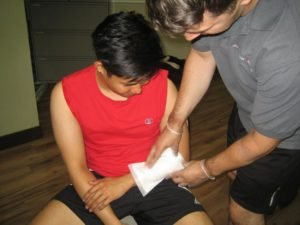A partial thickness burn affects the upper 2 layers of the skin – epidermis and hypodermis. This type of burn continues to change over time and evolve into a full thickness burn even after primary treatment was provided.
It is important to note that a partial thickness burn can be serious and has a high likelihood for ending up with infection or other complications.
Possible causes
A partial thickness burn can be caused by friction, heat, light, electricity, chemical or even radiation. Most cases of burns are a direct result of exposure to flame or fire followed by scalds.
What are the types?

Aside from the depth, burns are categorized based on the severity such as major, moderate and minimal which are subject to the following factors:
- Depth of the burn
- Age of the individual
- Location of the burn
- Total body surface area affected by the burn
- Current injuries or conditions
Essentially, a partial thickness burn can be categorized into 2 – superficial and deep. The depth can be hard to determine and must be assessed by a doctor. The difference between superficial and deep is vital since the former can heal spontaneously on its own while the deep type necessitates surgical care.
What are the indications of partial thickness burns?
A superficial burn extends superficially into the second skin layer with the following symptoms:
- Clear blisters (open or closed)
- Reddened skin that blanches if pressure is applied
- Skin is painful and moist
Deep burns go deep into the second skin layer and rapidly progress into a full thickness burn with the following symptoms:
- Reddened and white skin that does not readily blanch
- Skin is moist and painful
- Bloody blisters
Who are at risk?
Children face the highest risk for burns as well as those in high-risk occupations such as:
- Occupations that involve working with flames, heat or sparks
- Those working with combustibles, chemicals or radioactive materials
- Individuals who work with electrical equipment
Management
Partial thickness burns are considered serious and must be treated by a healthcare professional right away. First aid measures can be started before medical care which include the following:
- Transfer the individual away from the source and get rid of any clothing around the burn site.
- Flush the burn using cool water for about 15 minutes and pat the area dry using a clean cloth
- Avoid breaking any blisters that form and do not use ice to cool the burn.
- Immerse a clean cloth in cool water, wring out the excess and apply to the burn as a compress.
- Bandage or wrap the burn using a non-adhesive bandage or sterile cloth to protect against bacteria and debris.
- The burn should be assessed by a doctor at the same day.
More Information / Disclaimer
The information posted on this page on partial thickness burns is for learning purposes only. Learn to recognize and manage different types of burns including a partial thickness burn by taking a standard first aid course with one of our training providers.
